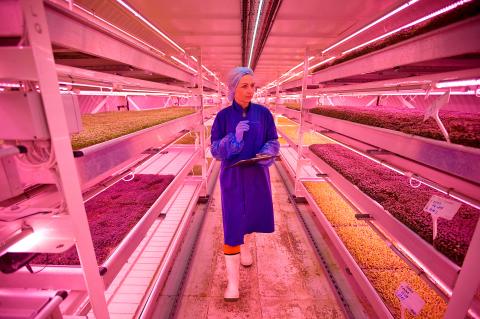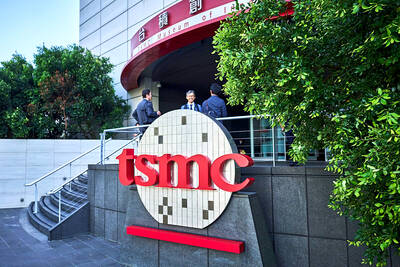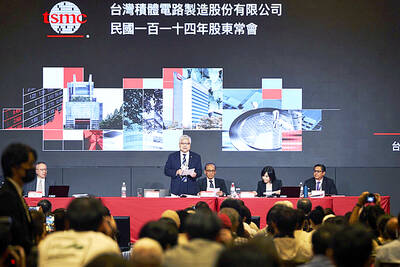Under an anonymous back street in south London lies a vast underground air-raid shelter that has been turned into a pioneering urban farm supplying supermarkets and restaurants in the capital.
The World War II shelter in Clapham, which could protect up to 8,000 people from Nazi German bombs, consists of two large tunnels that were intended to one day become an extension of the London Underground.
That never happened and the shelter was abandoned for 70 years until two entrepreneurs, Steven Dring and Richard Ballard, decided to grow broccoli, coriander, fennel and a host of other vegetables as so-called “micro leaves,” also known as micro herbs, grown from seedlings, but harvested early when the first leaves form.

Photo: AFP
“We need to create these new fertile spaces” to meet increased demand from a growing global population, Dring told AFP on a visit to Growing Underground — about 33m below the road.
Staff wear protective clothing and there is a strong smell of vegetables and humidity in the shelter. The vegetables are grown with hydroponics, using nutrient solutions in a water solvent instead of soil.
The technique can also be used to grow a wide range of produce, including tomatoes and baby peppers, Dring said.
The only other ingredient required is light.
The tunnels have no natural light and are illuminated with pink LEDs, giving them a futuristic look.
The intensity of the light changes to imitate daylight, but with one major difference — the lights are dimmed during the day and shine brightest at night, as electricity is cheapest then.
“We predominantly grow micro herbs, which are standard herbs, from different seeds, but what we do is we grow them to a very small stage, before the first true leaves start to come out,” Dring said.
Micro herb broccoli takes between three and five days to grow before being packaged up in the shelter and sent off.
Fans rave about the intensity of the flavors of the produce.
Customers include Marks and Spencer PLC, which offers the produce in some of its supermarkets, several stalls at London’s Borough Market and many restaurants — helped by the patronage of celebrity chef Michel Roux Jr of Le Gavroche.
Dring and Ballard latched onto the concept of vertical farming — producing food in vertically stacked layers — which was developed by US biologist Dickson Despommier in his 2010 book The Vertical Farm: Feeding the World in the 21st Century.
The operation takes up about 200m of the 1km available in the air-raid shelter tunnel, half for growing while the other half is used for packaging.
Their request to use the air-raid shelter in Clapham was eagerly taken up by the owners of the space, London’s public transport company.
This type of farming is “100 times cheaper” than setting up an urban farm on the surface, Dring said.
Their customers have said they are happy with the result.
“I think the story is fantastic,” said Charlie Curtis, an agronomist at Marks and Spencer.
“I think we all love to think that our food is grown locally to us, but I think also the product sells itself. The quality is fantastic and the flavor is like something I’ve never had before,” she said.
Experts have said vertical and urban farming could be ways not only of facing up to population growth, but also growing urbanization worldwide, as well as climate change.
Nottingham University’s Centre for Urban Agriculture said on its Web site that urban farms create jobs, reduce transport costs and pollution, as well as offer an “opportunity to develop technologies.”
The Growing Underground project sends its data on humidity, temperature and plant growth to Cambridge University to try and improve efficiency.
“What these guys are doing is modeling for us which one is the optimum environment for each product,” Dring said.
Every day is the same in the underground farm and there are no seasons, or unpredictable British weather.
“We have a lot more control than usual growers... When in the winter days it’s cold under the glass, it will take you 25 days to grow red mustard,” Dring said. “It will always take us 10 days to grow red mustard.”
“There’s nothing that stands as a major challenge, apart from building a farm underneath London,” he added.

With an approval rating of just two percent, Peruvian President Dina Boluarte might be the world’s most unpopular leader, according to pollsters. Protests greeted her rise to power 29 months ago, and have marked her entire term — joined by assorted scandals, investigations, controversies and a surge in gang violence. The 63-year-old is the target of a dozen probes, including for her alleged failure to declare gifts of luxury jewels and watches, a scandal inevitably dubbed “Rolexgate.” She is also under the microscope for a two-week undeclared absence for nose surgery — which she insists was medical, not cosmetic — and is

CAUTIOUS RECOVERY: While the manufacturing sector returned to growth amid the US-China trade truce, firms remain wary as uncertainty clouds the outlook, the CIER said The local manufacturing sector returned to expansion last month, as the official purchasing managers’ index (PMI) rose 2.1 points to 51.0, driven by a temporary easing in US-China trade tensions, the Chung-Hua Institution for Economic Research (CIER, 中華經濟研究院) said yesterday. The PMI gauges the health of the manufacturing industry, with readings above 50 indicating expansion and those below 50 signaling contraction. “Firms are not as pessimistic as they were in April, but they remain far from optimistic,” CIER president Lien Hsien-ming (連賢明) said at a news conference. The full impact of US tariff decisions is unlikely to become clear until later this month

GROWING CONCERN: Some senior Trump administration officials opposed the UAE expansion over fears that another TSMC project could jeopardize its US investment Taiwan Semiconductor Manufacturing Co (TSMC, 台積電) is evaluating building an advanced production facility in the United Arab Emirates (UAE) and has discussed the possibility with officials in US President Donald Trump’s administration, people familiar with the matter said, in a potentially major bet on the Middle East that would only come to fruition with Washington’s approval. The company has had multiple meetings in the past few months with US Special Envoy to the Middle East Steve Witkoff and officials from MGX, an influential investment vehicle overseen by the UAE president’s brother, the people said. The conversations are a continuation of talks that

CHIP DUTIES: TSMC said it voiced its concerns to Washington about tariffs, telling the US commerce department that it wants ‘fair treatment’ to protect its competitiveness Taiwan Semiconductor Manufacturing Co (TSMC, 台積電) yesterday reiterated robust business prospects for this year as strong artificial intelligence (AI) chip demand from Nvidia Corp and other customers would absorb the impacts of US tariffs. “The impact of tariffs would be indirect, as the custom tax is the importers’ responsibility, not the exporters,” TSMC chairman and chief executive officer C.C. Wei (魏哲家) said at the chipmaker’s annual shareholders’ meeting in Hsinchu City. TSMC’s business could be affected if people become reluctant to buy electronics due to inflated prices, Wei said. In addition, the chipmaker has voiced its concern to the US Department of Commerce